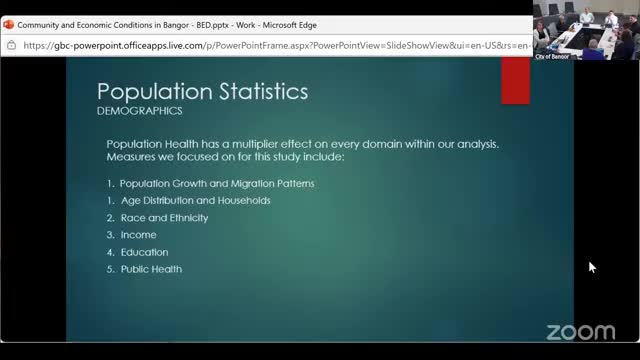Bangor Reports Population Changes Amid Diverse Migration and Economic Challenges
August 18, 2025 | Bangor City, Penobscot County, Maine
This article was created by AI summarizing key points discussed. AI makes mistakes, so for full details and context, please refer to the video of the full meeting. Please report any errors so we can fix them. Report an error »

In the heart of Bangor, Maine, city officials gathered to dissect the latest population statistics, revealing a complex tapestry of growth, migration, and demographic shifts that could shape the future of the community. As the meeting unfolded, the committee delved into the nuances of who lives in Bangor, where they come from, and the implications of these trends on local economics and social structures.
The discussion began with a stark revelation: since the 2010 census, Bangor's population has decreased from approximately 33,000 to an estimated 31,000 in 2024. This decline, attributed to various migration patterns, highlighted the challenges faced by rural areas like Maine. Notably, while the state welcomed an influx of 5,300 new residents in 2024, only a small fraction—less than 1%—of Bangor's newcomers were international migrants. Instead, domestic migration accounted for 18% of the population changes, indicating a significant movement within the state and from other U.S. regions.
The committee presented infographics that illustrated these trends, showcasing fluctuations in population growth year over year. For instance, Bangor experienced a notable 3% growth in 2020, but this was followed by a decline in 2021 and a slight recovery in 2024. Such statistics not only reflect the city's demographic landscape but also raise questions about the economic vitality and social fabric of the community.
As the meeting progressed, the focus shifted to the city's multicultural composition. While Bangor remains predominantly white, there is a growing presence of Native American and indigenous populations, contributing to the city's cultural diversity. The median age of residents has also decreased slightly, now standing at 40.7 years, with nearly a quarter of the population aged 62 and older, and about 18% being children. This demographic shift underscores the importance of understanding family dynamics and household structures, particularly as the number of single-person households rises.
The committee highlighted that over 25% of Bangor residents live below the federal poverty line, with many relying on fixed incomes. This statistic serves as a critical reminder of the economic challenges faced by a significant portion of the community, particularly those raising children alone or navigating the complexities of aging.
As the meeting concluded, it became clear that the insights gathered would not only inform future policy decisions but also foster a deeper understanding of the community's needs. The discussions illuminated the intricate relationship between population dynamics and economic development, emphasizing the importance of creating an inclusive environment that supports all residents. With these findings in hand, Bangor stands at a crossroads, poised to address its challenges while embracing the opportunities that come with a diverse and evolving population.
The discussion began with a stark revelation: since the 2010 census, Bangor's population has decreased from approximately 33,000 to an estimated 31,000 in 2024. This decline, attributed to various migration patterns, highlighted the challenges faced by rural areas like Maine. Notably, while the state welcomed an influx of 5,300 new residents in 2024, only a small fraction—less than 1%—of Bangor's newcomers were international migrants. Instead, domestic migration accounted for 18% of the population changes, indicating a significant movement within the state and from other U.S. regions.
The committee presented infographics that illustrated these trends, showcasing fluctuations in population growth year over year. For instance, Bangor experienced a notable 3% growth in 2020, but this was followed by a decline in 2021 and a slight recovery in 2024. Such statistics not only reflect the city's demographic landscape but also raise questions about the economic vitality and social fabric of the community.
As the meeting progressed, the focus shifted to the city's multicultural composition. While Bangor remains predominantly white, there is a growing presence of Native American and indigenous populations, contributing to the city's cultural diversity. The median age of residents has also decreased slightly, now standing at 40.7 years, with nearly a quarter of the population aged 62 and older, and about 18% being children. This demographic shift underscores the importance of understanding family dynamics and household structures, particularly as the number of single-person households rises.
The committee highlighted that over 25% of Bangor residents live below the federal poverty line, with many relying on fixed incomes. This statistic serves as a critical reminder of the economic challenges faced by a significant portion of the community, particularly those raising children alone or navigating the complexities of aging.
As the meeting concluded, it became clear that the insights gathered would not only inform future policy decisions but also foster a deeper understanding of the community's needs. The discussions illuminated the intricate relationship between population dynamics and economic development, emphasizing the importance of creating an inclusive environment that supports all residents. With these findings in hand, Bangor stands at a crossroads, poised to address its challenges while embracing the opportunities that come with a diverse and evolving population.
View full meeting
This article is based on a recent meeting—watch the full video and explore the complete transcript for deeper insights into the discussion.
View full meeting
